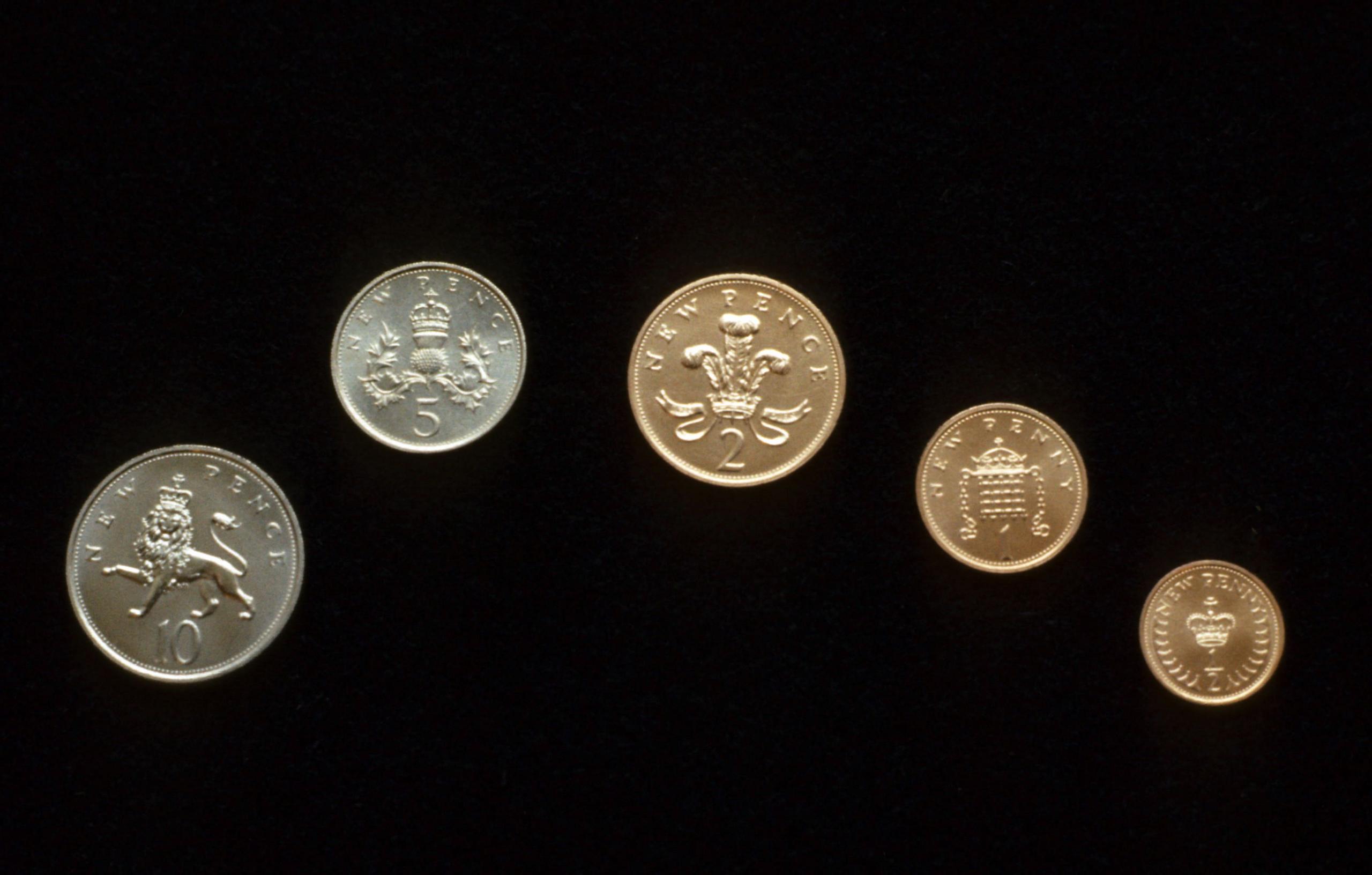
The sparkling new coins included the halfpenny on the right
“Every man who looks at his ten fingers saw an argument of its use, and an evidence of its practicability.”
The above statement was made by Sir John Bowring MP to the House of Commons in 1847, but official attempts to introduce decimal currency in the UK can be traced back as far as 1824, when Sir John Wrottesley’s proposals to decimalise sterling were rejected by Parliament.
On 15 February 1971 – Decimal Day – the British currency system finally switched over from the old £sd system of pounds, shillings and pence to the current decimal system.
The change, however, didn’t really happen overnight. Here, told through the medium of archive video clips, is the story of Decimal Day.
How might decimal currency work?
1961: The government agrees in principle to introduce decimal coins. How might it work?
The successful transition to decimal currency in South Africa led the UK Government to set up the Committee of the Inquiry on Decimal Currency – known as the Halsbury Committee – which was tasked with the following:
-
To advise on the most convenient and practical form which a decimal currency might take, including the major and minor units to be adopted.
-
To advise on the timing and placing of the changeover best calculated to minimise the cost.
-
To estimate the probable amount and incidence of the cost to the economy of the proposals based on the above terms of reference.
In the above 1961 clip from BBC News, currency expert Mr Martin explains – in rather convoluted terms – how a transition to decimal currency might work.
Preparation for decimalisation
In 1963, the Halsbury Committee published its findings.
Lord Halsbury concluded that, due to the pound’s importance as a global reserve currency, it should remain the main unit of currency.
A series of new decimal coins could then be created in support of the pound, while all existing coins would either be replaced, where possible, or phased out entirely.
Vox pops find mixed reaction
1963 News clip: Londoners discuss the UK’s potential switch to decimal currency
“The whole of Europe has a decimal system, why not us? I think we’re well behind the times.”
“I’m too old and I’d never get to understand them.”
Public reaction to the prospect of decimal currency was mixed, if these vox pops with Londoners from 1963 are anything to go by.
Spotlight considers some of the pros and cons of the decimal coinage system being adopted in the UK (Broadcast 17 October, 1963)
Lord Halsbury explains why the pound will form the basis of the new system, and demonstrates mockups of the new coins (Broadcast 23 September, 1963)
A Treasury spokesman discusses the potential timescale and cost for implementing the Halsbury report (Broadcast 23 September, 1963)
The new coins
Chancellor of the Exchequer, James Callaghan, announced on 1 March 1966 that the changes proposed in the Halsbury report would be adopted, paving the way for the introduction of new decimal coins.
Shoppers get to grips with the new 5p and 10p coins (Broadcast 23 April 1968)
“Don’t give me that bloody new money ‘cos I don’t want it!”
On 23 April 1968, two new decimal coins were released; the 5-pence piece and the 10-pence piece. To make the transition to decimal as easy as possible, these coins were the same size (and value relative to the pound) as the pre-decimal 1-shilling and 2-shilling coins, so they could theoretically be used in existing vending machines.
In October 1969 a third new decimal coin was released; the equilateral-curve heptagon (or Reuleaux polygon, if you prefer) 50-pence piece, to replace the 10-shilling note.
The early release of these coins allowed people to familiarise themselves with decimal currency, and meant that on Decimal Day only three completely new coins would be released, as opposed to six.
What to do with these fancy new coins
Peter Purves proudly presents the 50 pence piece. Why not make a tasteful Blue Peter display case for your coins? (Broadcast 13 October, 1969)
Would the new decimal coins make it more expensive to ‘spend a penny’ in the loo? Philip Tibenham reports from a Torquay public toilet (Broadcast 31 December, 1969)
With less than three years to Decimal Day, The Money Programme asks business owners and bankers just how prepared the UK is for the transition (Broadcast 25 April, 1968)
How much is that in old money? Converting to decimal
John Humphrys looks at the leaflets and posters for the decimal switch and talks to Lord Fiske of the Decimal Currency Board (Broadcast 29 December, 1970)
“I don’t really see the necessity for chaos and confusion – we are about to undertake one of the biggest public education programmes that has ever been undertaken.”
In the months before Decimal Day, a huge media campaign – comprising posters, leaflets, songs (Decimalisation by Max Bygraves is a personal favourite), television ads, and conversion tables for shoppers – was rolled out.
The BBC broadcast several television programmes – Decimal Five for the general public, New Money Day for children and Training for D-Day (which you can see a clip from below) – for people whose jobs involved cash handling.
BBC Archive does not believe that the Government ever officially backed the ‘decimal fingers’ conversion method – though it might have helped out those decorators…
Three decorators, armed with the latest government literature, attempt to work out their wages in decimal currency (Broadcast 3 February, 1970)
Training for D-Day was a series on decimal money for people who handled cash in their jobs. Why not grab some coins and play along at home? (Broadcast 25 January, 1971)
Converting to decimal is easy, if you have giant cardboard fingers. The ‘decimal fingers’ conversion method is demonstrated to an audience of skeptical-looking housewives (Broadcast 12 February, 1970)
Decimal Day and beyond
Vox pop on Decimal Day itself – how are shoppers coping with the switch?
“I’m finding it very simple – I let them do the work.”
Decimal Day arrived, and with it came the new halfpenny, 1-pence and 2-pence coins.
Though there were some complaints – that shops were effectively raising prices by rounding up to the nearest pence, and a general consensus that the halfpenny coin was too small – the day itself went very smoothly.
1d and 3d coins were officially demonetised in August 1971, but the sixpence coin – now worth 2 and a half new pence – gained a stay of execution by popular demand, remaining legal tender for a further nine years, until June 1980.
Decimal Day marked the end of the Saltburn Halfpenny Toll Bridge’s 102-year fight against inflation. Still, at least it didn’t have to change its name. (Broadcast 10 February, 1971)
Could the public’s fondness for the humble sixpence earn it a temporary reprieve from decimalisation? These people hope so (Broadcast 19 February, 1970)
Decimal conversion is not a mug’s game, it really is child’s play, as this 1971 clip featuring an eagle-eyed Blue Peter viewer attests






